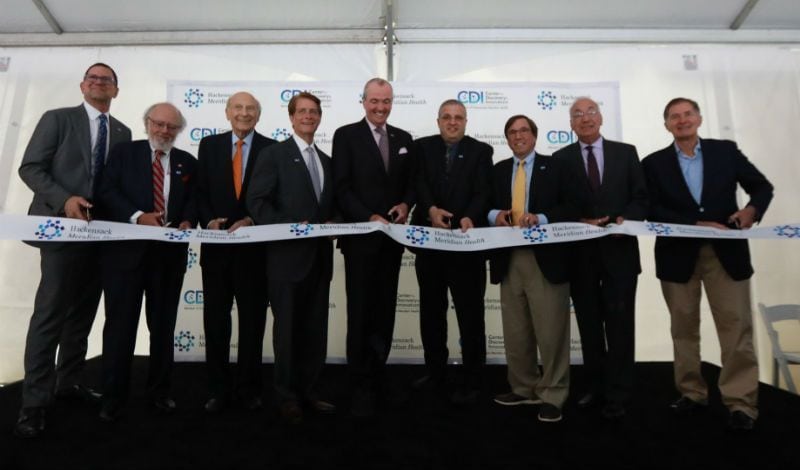HMH’s Center for Discovery and Innovation has ribbon-cutting to much fanfare – and anticipation

Shortly after Bob Garrett, the CEO of Hackensack Meridian Health, explained how the Center for Discovery and Innovation was going to transform health care in New Jersey and beyond — using science, technology and innovation to quickly discover and deliver health care solutions we can barely even conceive of today — Gov. Phil Murphy put the potential of the facility in perspective.
“This is the place where diseases that are now considered untreatable will meet their match,” he said.
Murphy, speaking to a crowd of a few hundred before the ceremonial ribbon-cutting, praised CDI as an example of the innovative economy he has championed for the state. And he called its employees true heroes.
“The individuals who will work in this state-of-the-art facility are the people who can see their way through the data, all the way to a cure,” he said. “These are the people who have a limitless potential for discovery.”
And, while he said their work will be felt by people around the world, its true benefit will be recognized one patient at a time.
“For anyone who has ever had an ailing loved one at home, you know the relief it brings when that person has a good day,” he said. “A day when they’re feeling strong, clear-headed, happy to be alive and spending more time with their family.
“Because of this institute, more New Jerseyans will have more days just like that. That is the goal of this institute, to be a leader in health care for all, and I can’t think of a better representation of the character of our state.”
CDI, located on the border of Nutley and Clifton in the same building that once housed the famed Roche Institute of Molecular Biology, has limitless potential, Garrett said.
“The Center for Discovery and Innovation will accelerate the timetable from discovery to treatment,” Garrett said. “This state-of-the-art center will create solutions to some of the world’s most difficult diseases, like cancer, diabetes and antibiotic resistant infections.
CDI will organize its research in three specialty institutes.
- The Institute for Cancer and Infectious Diseases, led by Dr. David Perlin: “This institute will become a national and global leader for improving patient outcomes through science-based personalized medicine,” Garrett said.
- The Institute for Multiple Myeloma, led by Dr. David Siegel: “(It) will transform the treatment of patients with multiple myeloma by integrating our extensive clinical expertise and research contributions with ongoing basic and translational research,” Garrett said. “We’ll build our networks program, one of the world’s largest, with more than 2,000 patients diagnosed with multiple myeloma on active therapy today.”
- The Institute for Regenerative Medicine: “We’ll offer novel solutions to heal damaged tissues and organs and provide hope to restore health for patients with conditions that today cannot by treated,” Garrett said. “Groundbreaking research shows the promise or reversing progression of diseases.”
Garrett credited Dr. Andrew Pecora, who recently announced his departure as HMH’s chief innovation officer, for the final institute.
“The fact that history is becoming a reality is due to his perseverance,” Garrett said.
Pecora returned the compliment.
“Bob and I have been talking about the concept of CDI for over a decade,” he said. “And we had a tall vision. We wanted this place to become synonymous with Silicon Valley, Research Triangle, Bell Labs. And I can go on and on.”
Pecora feels gathering so many top scientists and researchers in one place will lead to breakthroughs of the first order.
“In the last five years, we have learned more as a species than what we learned in the last 50 years,” he said. “It’s hard to imagine. And very soon, three fields of science — material science … computational science … and life science, particularly stem cell research and gene editing — are all going to come together into some amazing focal point that is truly going to change the human experience.”
Perlin, the chief scientific officer at CDI, said improving the human experience is at the heart of the center.
“The CDI was really created to capture the renaissance of science and make it work for patients with cancer and infectious diseases, whether they are acute or chronic diseases,” he said. “That is our goal.”
Perlin estimated CDI is approximately 75 percent staffed.
“We’re off to a fast start,” he said. “We’ve recruited 13 faculty members, we have more than 80 grants and contracts, we have 18 grants from the NIH, but there’s a lot more to come.
“By the end of this year, we’ll have 15 or 16 laboratories in place, perhaps 100 scientists working toward a common goal.”
That goal: improving patient outcomes.
“That’s what it’s all about,” he said. “We will, along the way, generate lots of grants, lots of outstanding papers, we will generate patients and products, but, at the end of the day, it has to be: Are we improving patient outcomes? That has to be the metric that guides us. And it will.
“For too long, the medical profession has accepted that we diagnosed patients with cancer too late, that therapies are not quite effective enough and certain people will relapse, that infections that could be treated with antibiotics will become resistant, and we say (to) patients with debilitating diseases, there’s not much we can do. We have to change that thinking.”
That’s what CDI is all about, Perlin said.
“We seek a new medical paradigm,” he said. “That that sort of thinking is not acceptable, that we have to bring science to the table and overcome all of these challenges. That’s our goal. That is our mission. The CDI will be a force for change. And we will bring world-class translational research, together in the Hackensack Meridian Health environment, to affect this change.”
Read full article here.